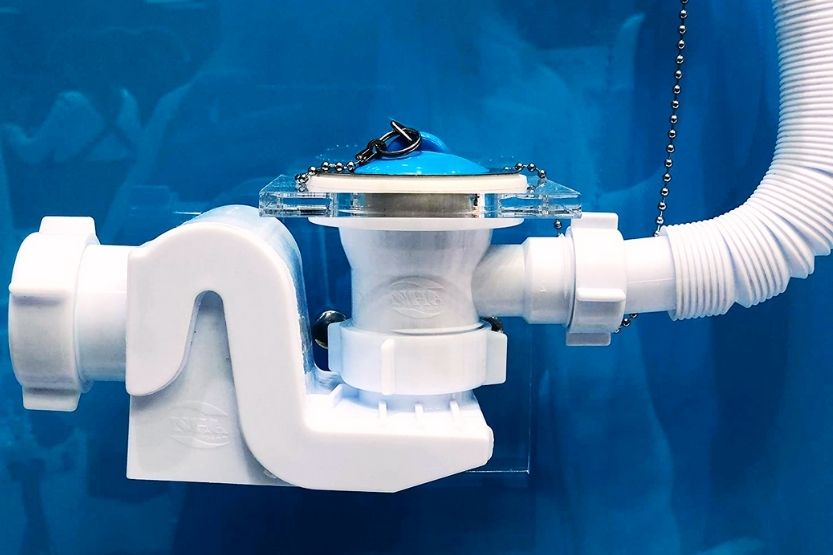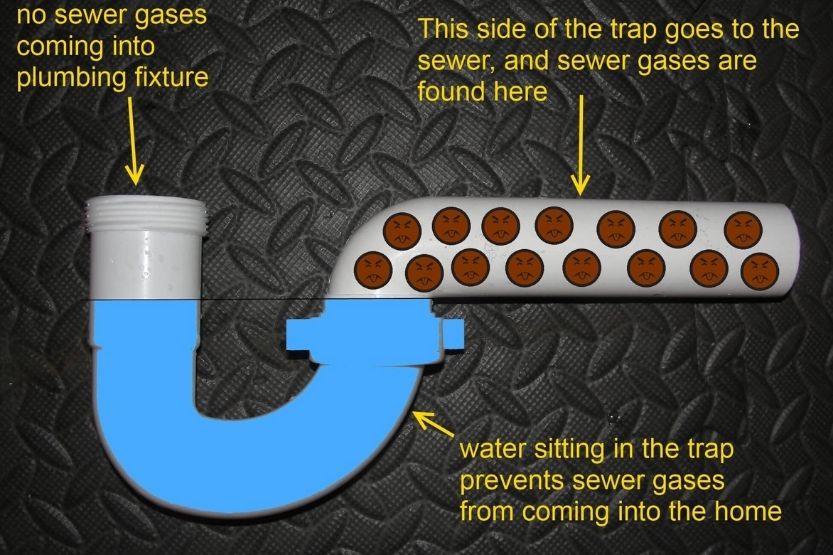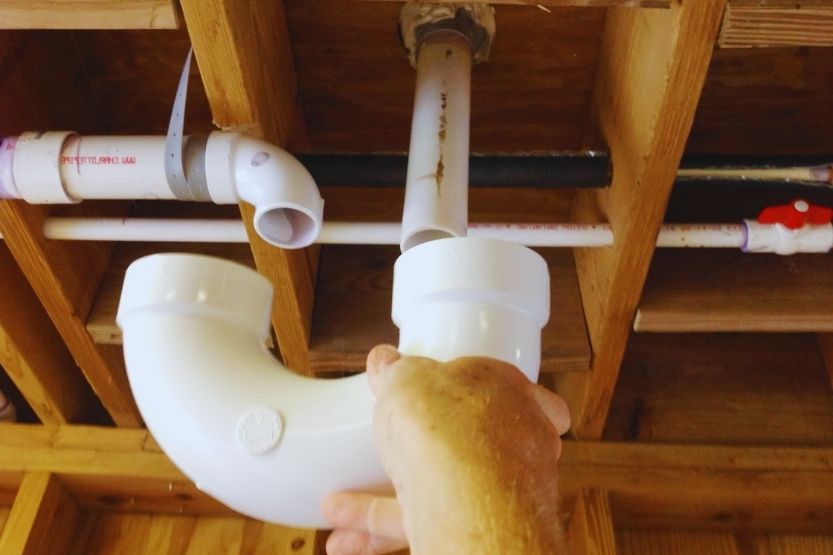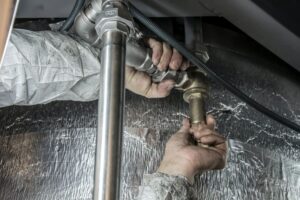Most homeowners are not aware of what a shower P-trap is until they experience problems in their bathrooms. That’s why it is also important for you to know what this plumbing component does in your bathroom. Shower P-trap – what is it, and how do you install it?
Shower P-traps are curved pipes under all types of drains and showers. A P-trap has many functions. It can direct wastewater out of your home. A P-trap also provides a barrier so that sewer fumes and small and dangerous organisms cannot enter your living space.
Since the shower P-trap leads wastewater away from your home, it should be beneath the drain hole of your bathroom. In the kitchen, it is underneath the drain hole of the kitchen sink. This P-trap can be one solid piece of metal pipe. It can also be an extension pipe connected to a J-bend pipe, forming the ‘P’ shape.
Read on to learn more about the shower P-trap, what it is, its function, and how you can install it.
Also, for an excellent Shower P-trap, take a look at Bath Shower Drain Flat P-Trap on Amazon to see its price and great reviews:
Click here to see it on Amazon.
Shower P-trap

Curved Pipe Under the Drain Hole
A shower drain p-trap is a curved pipe under the drain hole of the bathroom. Its main function is to direct wastewater away from your home. But it also acts as a barrier that prevents bad odor from the sewer and the dangerous small organisms from entering your living space.
Made from Metal or PVC Pipe
It is usually a metal pipe or PVC with a U-shaped bend connected to the plumbing line that drains or directs water to a sewer line. As a trap, it contains water all the time.
Serve as a Protective Barrier Against Unwanted Smell
In this way, it can serve as a protective barrier so that unwanted smells and organisms can’t enter your home. A shower p-trap can be a solid piece of metal, a PVC pipe, or an extension connected to a J-bend pipe, forming the ‘P’ shape.
A Requirement by Law
Building codes or regulations require all shower drains to have their respective P-traps. The exact requirement applies to all piping fixtures in a building’s plumbing system. So, by the law’s definition, the P-trap is an integral part of your house’s plumbing system.
P-trap Shower Drain Components
There are three main components of a p-trap shower drain:
- Inlet where water enters,
- Downward bend where the clean water is trapped, and
- Outlet where the wastewater is directed to the sewer.
Many homeowners enjoy P-traps’ services without really knowing what they are and how they work. It is only when their P-traps become clogged that they realize their importance. In that regard, homeowners should learn how to use and care for the P-traps in their showers properly.
Why Is It Called P-trap
The P-trap, a piece of pipe plumbing, has a P-like shape. The only thing different is that the ‘P’ is not standing up but lying down. You’ll notice that the bent part is facing downwards.
With this bend lying down, the P-trap can then ‘trap’ water from the drain hole. This trapped water acts as a vapor barrier between your indoor living space and the sewer line. The trapped water is not dirty but is clean water that came from your shower faucet.
A good P-trap that you can install in your shower is Aniplast’s Bath Shower Drain Flat P-Trap. Also, you can use this pipe in acrylic bathtubs:
Click here to see it on Amazon.
So, don’t be afraid of that trapped water. The water pressure from your shower faucet flushes out the wastewater directly to the sewer. As your shower faucet continues to pour water into the drain, the bent part of the P-trap traps the clean water.
It is the final section of the plumbing where clean water is present. In other words, wastewater won’t stay on the P-trap – unless you have a clogged P-trap. If this is the case, then you need to de-clog, repair, or replace the P-trap.
How Do P-Traps Work?

The main function of the P-trap is to prevent gas from the sewer from coming up via your drain pipes and entering your indoor living spaces. These fumes have a foul smell and are dangerous to your health if inhaled.
Vapor Barrier Prevents Fumes from Escaping the Pipe
The vapor barrier in the bend of the P-trap prevents these fumes from passing through and entering your home. The P-trap also provides an unintended benefit. If you accidentally dropped a precious ring or jewel on the shower drain, it will settle down in the bend of the P-trap.
You can retrieve your precious ring or jewel by unscrewing the cleanout tap at the bottom of the bend of the P-trap. This is a task that you can easily perform as long as you have the proper tools.
This plumbing component is essential so much so that most building codes require that it be a part of the plumbing system of any structure. Some of the plumbing systems even have P-traps built into their plumbing lines.
Backflow Prevention System
A P-trap uses a backflow prevention system to prevent sewer gas from entering the house. A standard P-trap has two 90° joints attached to a horizontal overflow pipe. One of these joints leaves the drain of the sink.
It is linked to another pipe that seals the water. This system allows water to flow into the overflow pipe but does not allow it to flow backward into the sink. So, sewer gas cannot flow into the house.
Fumes from the sewer can smell like rotten eggs. At their worst, they are poisonous and, given the right conditions, can even explode. The water barrier created inside the P-trap prevents these situations from happening.
If the P-trap is clogged, or if you have dropped some precious thing inside the drain, you can easily clean it or retrieve it by unscrewing the cleanout tap at the bottom of the bend in the P-trap.
Another P-trap designed for showers that you can consider is the EasyDrain Ref. 510 Expandable & Flexible. You can easily remove this polypropylene P-trap to clean in case it has a clog:
Click here to see it on Amazon.
Again, what is a Shower P-trap? A Shower P-trap is a P-shaped pipe beneath all kinds of showers and drains. Aside from directing wastewater away from your home, it also prevents dangerous fumes from entering your home.
How to Install a Shower P-Trap

Installing a shower drain p-trap is relatively easy. If you have decent handyman skills, you can do it yourself. Just be sure that your local government building code approves the P-trap you are installing.
Factors to Consider
There are some considerations you need to think about before starting to install a p-trap shower drain:
1. Not Allowed to Install More Than Three Utilities Into a P-trap
In the majority of the cities in the United States, you cannot install more than three utilities or drain pipes into a P-trap. In other words, if you have more than four sinks in your shower, you should use at least two P-traps.
2. Have a Trap Primer
If you installed a P-trap in an infrequently used plumbing line, it should have a trap primer. This primer will help maintain the seal in place to prevent the passage of sewer gas.
3. Install a P-trap When Constructing a New Bathroom
Installing a P-trap on a shower is usually done during the construction of a new bathroom. It comes together with all the plumbing fixtures. If the bathroom is undergoing renovation, the homeowner usually installs a new P-trap.
Steps in P-trap Installation or Replacement
Installing or replacing a shower P-trap requires the same procedure. But the job is more difficult when installing or replacing a kitchen sink P-trap. Shower P-traps are more difficult to access. That’s why the best time to replace a shower P-trap is when you are renovating your shower:
1. Cut the Subfloor
The first step is to cut the subfloor around the shower drain using an electric saw for precise and easy cutting. You can cut 12 inches by 12 inches square around the drain. Be sure to cut only the sections that are running over the floorboards.
If you do this, you will have parts of the subfloor where you can nail it back into its former place after you have finished installing or replacing the P-trap.
2. Pry Out the Square
Get a pry bar and use it to remove the square out of the floor. Make sure all the edges of the square are flushed. This will ensure that the subfloor will fit neatly back in once you have finished the installation.
3. Cut the Drain Off
When you have removed the square piece, get a portable power saw or hack saw with a fine-tooth blade and cut the drain off right after the P-trap. Use a rag to remove any burrs from the cut end of the pipe. Throw this piece in the trash.
4. Connect the New P-Trap
Now you can connect the new P-trap to the end of the pipe. You may have to use a reducer if the size of the pipe that comes up from the shower floor is different from the size of the new P-trap. A reducer will enable you to fit a smaller pipe to a bigger pipe.
Before connecting the reducer to the new P-trap, get high-quality pipe glue, spread it on the inside of the reducer and the P-trap, and connect them firmly. Be sure that the P-trap is properly in place.
5. Reattach the Square Piece
Get the square piece of the subfloor and reattach it to its former position. And then measure the distance from the subfloor to the new P-trap. Take note of that distance.
6. Cut a Piece of ABS Piping
Get a piece of ABS piping and cut it according to the measurement that you have just taken. Apply a liberal amount of glue to the inside of this ABS piping and the end of the P-trap. And then connect this cut piece of ABS piping to the end of the P-trap. Be sure that the connection is firm.
7. Reattach the Shower Drain
After ensuring that all connections are firm, you can now reattach the shower drain and complete the job.
8. Additional Tips
Install Plumber’s Straps or Pipe Support Hooks
To ensure that the P-trap and the connecting pipes are in place, you can install some plumber’s straps or pipe support hooks. You can use small nails to attach the straps or hooks to the underside of the subfloor.
Allow the Glued Joints to Set and Cure
Give the glued joints time to set and cure. The complete curing or setting of the glue will take place several hours after it is applied. So, it is best to leave the joints untouched overnight before testing the plumbing connections for leaks.
Apply Thick Coats of PVC Cement
If you notice water drippings from a connection, apply thick coats of PVC cement around the portion where the leak is present. This will hopefully stop the drips.
Conclusion: Shower P-trap
Shower P-traps are curved pipes that are commonly installed under all kinds of showers and drains. They fulfill many important functions in your home. A P-trap can direct wastewater out of your home. It also provides a barrier that prevents sewer fumes and small and dangerous organisms from going inside your living space.
Related reading:
Kitchen Sink Clogged Past Trap – How to Fix – 6 Steps








![Drum Trap - What Is It? [Drum Traps FAQs] what is a drum trap](https://homecarezen.com/wp-content/uploads/2022/01/what-is-a-drum-trap-150x150.jpg)


![Read more about the article Hot Water Not Working but Cold Is [How to Fix]](https://homecarezen.com/wp-content/uploads/2021/10/hot-water-not-working-but-cold-is-300x200.jpg)